外研版英语六年级上册第六模块第一单元教案
外研版英语六年级上册Module 6 Unit 1 -课件
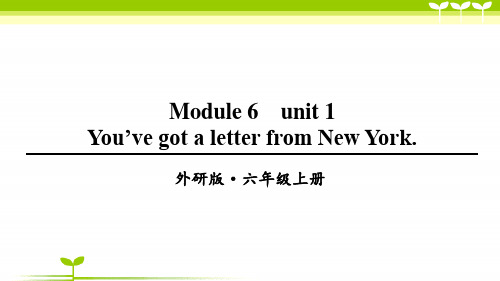
3. It’s difficult for me. 它对我来说是困难的。 difficult是形容词,意思是“困难的”。 主要指不容 易理解、不容易做或不好处理的事情。“某事+be difficult for+某人.”意思是“某事对某人来说是困难 的”。 【例句】 Singing is difficult for me. 唱歌对我来说是困难的。
2.I’ve got a book about the world. 我有一本关于世界的书。 “主语+have/has got+其他.”,这是用来表达“某人
有某物”。 【例句】 I have got a pet dog. 我有一只宠物狗。
have 的常见句型:
2 Listen and read.
Dear Sam and Amy, I am Daming’s friend and I want to be your friend too. I live in New York, but I am not American. I am from London in the UK. So we are all British! Do you like China? I want to visit China next year. Daming has got a Chinese dragon kite and we often fly it in the park. It’s difficult for me. Have you got a book about the US? I can send you one. Please write to me and we can be pen friends. Daming says he will write to you soon. Best, Luara
Module 6(教案)外研版(一起)英语六年级上册

Module 6(教案)外研版(一起)英语六年级上册一、教学目标1.学习新单词:bus driver, ticket, seat, driver, passenger, map, signal, turn left/right, straight。
2.通过听力、口语和阅读学习关于旅行的词汇和表达方式。
3.能够简单描述路线和交通工具。
4.能够熟练使用目标语言进行口头交流。
二、教学重点和难点1.教学重点:掌握本课所学新单词及交通工具的表达方式。
2.教学难点:学生如何描述目的地及交通方式。
三、教学过程A. Warm-up1.给学生出示图片,让他们讨论图片内容。
如:一辆公交车,一张地图,一位司机等等。
B. Presentation1.出示新单词卡片,逐个学习新单词并解释其意思。
2.以简短的句子形式来介绍新单词的用法。
如:He is a bus driver. She has a ticket.3.听力训练:播放录音并让学生跟读新单词及句子,重点训练语音和语调。
C. Practice1.让学生口语练习新单词和句子,可采用配对、分组或对话的形式进行练习。
2.小组活动:让学生利用学习到的知识编写一个简单的对话,介绍如何乘坐公交车到达目的地,并分享给大家。
3.阅读练习:将一个简单的公交车路线图呈现给学生,让他们找出从一个地方到另一个地方最快的路线。
同时,练习如何查看地图和使用交通信号。
D. Production1.让学生在小组或一对一的情境中练习口头描述如何乘坐公交车到达目的地。
2.让学生通过简单的类比来练习如何描述到达目的地及乘坐的交通工具。
E. Extension1.让学生利用网络或其他资源,了解国内外不同地区的交通工具和交通文化,并分享给大家。
2.让学生创作一个小漫画,描述如何乘坐交通工具到达目的地并分享给大家。
四、作业1.完成课堂上的练习题,并背诵好的句子和单词。
2.利用所学知识讲解家庭和朋友如何乘坐公交车到达一些旅游景点。
六年级英语上册M6Unit1You'vegotaletterfromNewYork教案外研版三起

1.Game.
教师引导学生拿一个身边的东西,在讲台桌的下面敲出声响,然后其他同学根据声音来判断他有什么东西。
2.Practice in pairs.
教师引导学生看图片并完成练习。
熟悉如何用句型“You’ve got a letter from New York.
尝试应用
Discuss.
Who is the letter from?
The letter is from Laura.
Who is the letter for?
The letter is for Sam and Amy.
2. Watchandanswer.
Askstudentsto watch the first video andanswer:
6.Look and answer.
Hello, boys and girls. I’d like to show you something today.What countries are they?
教师出示中美国旗,询问学生是否知道这些是哪国国旗。
7.Listen andanswer.
Has he got a book about China?
Where does Laura live?
She lives in New York.
Where is Laura from?
She is from London in the UK.
3. Watch and answer.
播放第二遍视频,让学生了解更多信件的信息。练习本课重点句型:You’ve got a letter from New York.Daming hasgot a Chinese dragon kite and we often fly it in the park.
外研版英语六年级上册-Module 6 Unit 1 (教案)
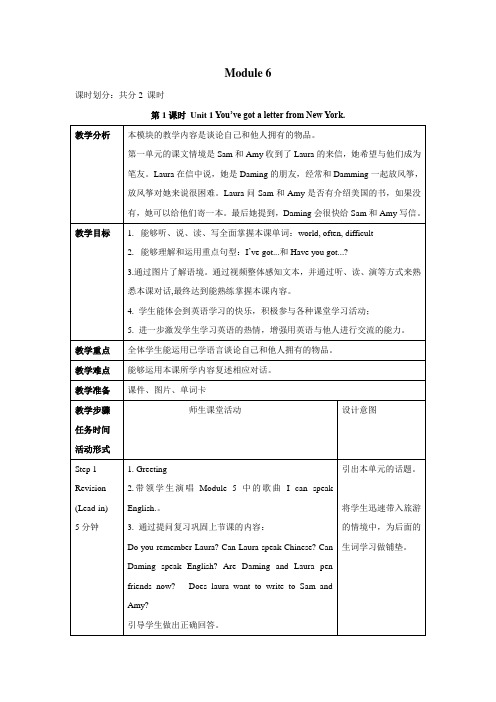
Step 5
homework
(5分钟)
Whole class
1.熟读课文。
2.我们已经了解了Laura给Sam和Amy去信的内容,请大家以Sam和Amy的名义给Laura写一封回信吧。
读写任务让学生进一步熟悉课文内容,运用并巩固所学生词。
板书设计
第1课时Unit 1You’ve got a letter from New York.
请学生看图,听录音并跟读,提醒学生注意模仿录音的语音语调。
鼓励学生根据发音规则读出生词,教师领读校正读音,并加深学生印象。
Step 4
Production
10分钟
Group work
Deal with Activity 4.
1.请学生观察课文中出现的连词“and”和“but”,教师引导学生发现这两个词连接的句子之间分别是什么关系(顺承和转折)并加以解析,完成第四部分练习题。全班一起核对答案。
4.让学生跟着录音读课文。分角色扮演。
引导学生理解练习要求。
拓宽学生的文化视野
Deal with Activity 2
(一)任务呈现
上一节课我们认识了一位新朋友Laura,她从Daming那里得到了Sam和Amy的通讯地址。今天,Sam和Amy收到了Laura的来信。让我们一起来看看信上都写了什么。
2. HasJohn got a book about the US?
3.What book hasJohn got?
再次播放录音,帮助学生理解语境。引导学生找到这些问题的答案。
2.使用图片等教具,带领学生学习单词“world”。
3.讲解课文中的重点句子:
针对“I’ve got a book ut the world.”中的have got进行讲解。
外研版小学英语六年级上册全册教案

外研版小学英语六年级上册全册教案一、教学内容本教案以外研版小学英语六年级上册为教材,教学内容涵盖全册章节,具体包括:1. Chapter 1: My School详细内容:介绍学校设施、地点及日常活动。
2. Chapter 2: My Hob详细内容:谈论个人爱好,学会使用一般现在时描述日常活动。
3. Chapter 3: My Weekend详细内容:描述周末活动,学会使用一般过去时。
4. Chapter 4: My Holiday详细内容:分享假日经历,运用一般过去时和一般将来时。
5. Chapter 5: Health详细内容:了解健康生活习惯,学习相关词汇和句型。
二、教学目标1. 能够熟练运用一般现在时、一般过去时和一般将来时描述个人经历和日常生活。
3. 增强学生合作交流意识,培养团队精神。
三、教学难点与重点教学难点:时态的运用、词汇拓展、句型表达。
教学重点:一般现在时、一般过去时、一般将来时的运用,以及相关词汇和句型的掌握。
四、教具与学具准备1. 教具:PPT、图片、录音机、磁带、卡片等。
2. 学具:课本、练习册、笔、纸张等。
五、教学过程1. 导入:通过展示与单元主题相关的图片,引导学生谈论个人经历,激发兴趣。
2. 新课内容展示:呈现新课词汇、句型和语法,配合PPT、录音机等教具进行讲解。
3. 例题讲解:针对难点和重点,进行例题讲解,帮助学生理解。
4. 随堂练习:设计相关练习题,让学生进行口头或书面练习,巩固所学知识。
5. 小组活动:分组进行讨论、交流,培养学生的合作能力和口语表达能力。
六、板书设计1. 单元主题2. 词汇:新课词汇、短语3. 句型:重点句型4. 语法:时态、语态等七、作业设计1. 作业题目:(1)抄写并背诵新课词汇、句型。
(2)根据所学内容,编写一段对话,描述个人经历。
(3)完成练习册相关练习题。
答案:见附件。
八、课后反思及拓展延伸2. 拓展延伸:(1)开展课后实践活动,如参观学校、采访同学等,提高学生实际运用能力。
外研版六年级英语上学期教学计划

外研版六年级英语上学期教学计划目标本教学计划旨在帮助六年级学生提高英语听、说、读、写的能力,培养他们的语言应用能力和跨文化交际能力。
教学内容1. 第一单元:欢迎回校- 课文内容:介绍学生的假期活动、学校设施等- 重点词汇:holiday, activity, library, playground- 语法项目:一般现在时- 听力训练:听懂并正确回答与假期活动相关的问题2. 第二单元:我的新老师- 课文内容:介绍学生的新老师,包括姓名、外貌、兴趣爱好等- 重点词汇:teacher, kind, strict, funny, music, painting- 语法项目:形容词的比较级- 听力训练:听懂并记录老师的个人信息3. 第三单元:我的学校生活- 课文内容:描述学校日常生活,包括上课时间、午餐时间、课外活动等- 重点词汇:schedule, lunch, after-school, club- 语法项目:一般过去时- 听力训练:听懂并回答与学校生活相关的问题4. 第四单元:我的家庭- 课文内容:介绍学生的家庭成员、家庭作业和家庭活动等- 重点词汇:family, member, homework, activity- 语法项目:there is/are- 听力训练:听懂并正确回答与家庭活动相关的问题教学方法本教学计划将采用多种教学方法,如听力练、口语表达、阅读文章、写作练和小组活动等。
通过多样化的教学手段,培养学生的综合语言能力和合作意识。
教学评估教学过程中将进行多次评估,包括课堂练、小组讨论和个人作业等。
通过这些评估活动,了解学生的研究进步情况,及时调整教学方法和教学内容。
教学资源为了支持学生的研究,将提供以下教学资源:- 外研版六年级英语教材及教辅资料- 多媒体设备和教学影音资料- 互动教学软件和在线研究平台以上是本学期六年级英语教学计划的总体框架,具体的每堂课内容和教学活动将根据学生的实际情况进行调整和补充。
(外研版)六年级英语上册教案 Module 6 Unit 1(4)
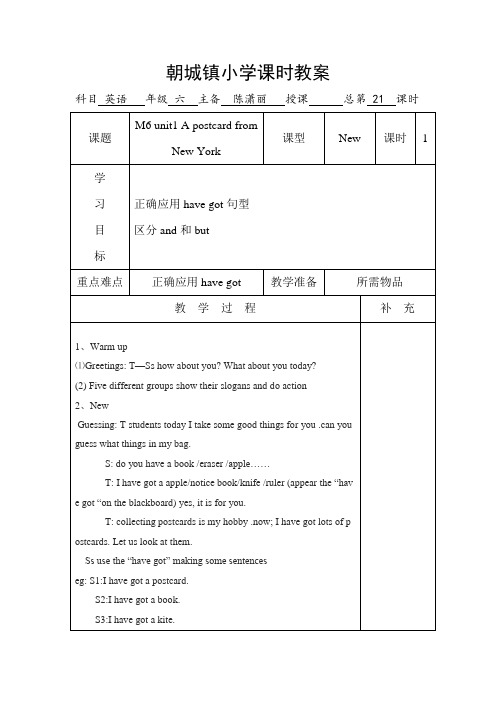
T: I have got a apple/notice book/knife /ruler (appear the “have got “on the blackboard) yes, it is for you.
T: collecting postcards is my hobby .now; I have got lots of postcards. Let us look at them.
朝城镇小学课时教案
科目英语年级六主备陈潇丽授课总第21课时
课题
M6 unit1 A postcard from New York
课型
New课时ຫໍສະໝຸດ 1学习目
标
正确应用have got句型
区分and和but
重点难点
正确应用have got
教学准备
所需物品
教学过程
补充
1、Warm up
⑴Greetings: T—Ss how about you? What about you today?
T:I’ve got a green book and he has got a blue book.
教师讲解and和but得区别
Practice
1、I’ve got a piano___I can’t play it.
2、Lili has got a piano___she likes it very much.
4、I can sing and I can dance
5、I can ride a bike but I can’t run fast
课后反思:
3、My cousin likes playing with me___I don’t like playing with him.
(三起点)外研版六年级英语上册《Module6__模块整体教案》

Module6 模块整体教案模块教学分析本模块主要学习句型:Darning has got a Chinese kite and we often fly it in the park. I’ve got a kite but I can’t fly it I’ve got a knife and fork, and chopsticks. I’ve got a stamp from China, but I haven’t got a stamp from Canada. 通过介绍不同国家的人们使用不同的物品进行文化对比,复习“have/has got”的用法。
第一单元教学内容围绕着主人公Darning的新朋友Laura写给Sam和Amy的一封请求成为他们的笔友的信展开了一系列对话和练习活动。
第二单元教学内容围绕中国小朋友玲玲和外国小朋友萨姆谈论个人所拥有的物品而展开。
本模块的教学重心应放在如何让学生用本模块主要句型“I have got... He/She has got… Have you got...?”谈论个人所拥有的物品,通过介绍不同国家的人们使用不同的物品进行文化对比,复习“have/has got”的用法。
本模块的功能是:初步掌握用本模块主要句型来谈论个人所拥有的物品。
第一单元主要是创设情景,引出话题从而进入重点语言知识的学习。
主要句型是Have you got..? Yes, I have. / No, I haven’t Darning has got a Chinese kite and we often fly it in the park 第二单元的主要句型是:I’ve got a knife and fork, and chopsticks. I’ve got a stamp from China, but I haven’t got a stamp from Canada.模块教学目标☆知识目标1. 能理解并会说唱Unit 2 Activity 5 Listen and say. Then chant.2. 能听、说、读、写Unit 1 Activity 1 Look, listen and say. Activity 3 Listen and say. Unit 2 Activity 1 Look, listen and say. Activity 2 Listen and read.中的单词和句子。
小学英语外研版六年级上册《Module6Unit1》教案
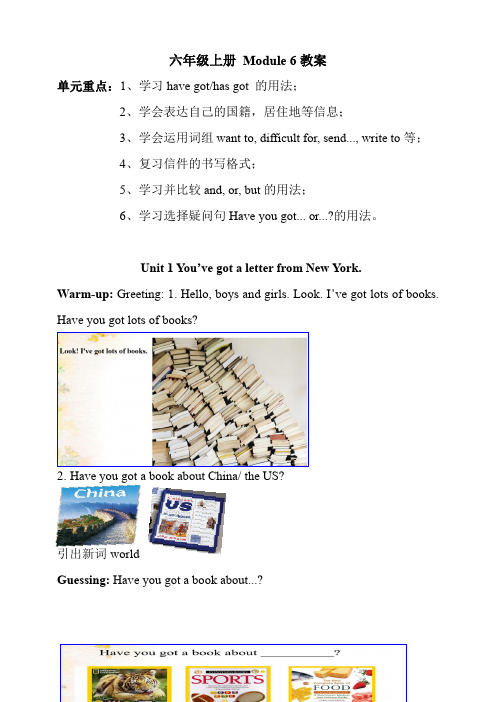
六年级上册Module 6教案单元重点:1、学习have got/has got 的用法;2、学会表达自己的国籍,居住地等信息;3、学会运用词组want to, difficult for, send..., write to等;4、复习信件的书写格式;5、学习并比较and, or, but的用法;6、学习选择疑问句Have you got... or...?的用法。
Unit 1 You’ve got a letter from New York.Warm-up: Greeting: 1. Hello, boys and girls. Look. I’ve got lots of books. Have you got lots of books?2.Have you got a book about China/ the US?引出新词worldGuessing: Have you got a book about...?Activity 1: What books has John got? (播放活动1部分的视频)Activity 2: Look. Sam and Amy have got a letter. It’s from New York. It’s from .... 提出问题,让学生思考并视听活动2部分的视频内容。
It’s a letter from Laura. Please say something about Laura. 让学生再读信件第一段,并找出Laura的相关信息。
Laura is Daming’s friend. She lives in New York. She’s from London. She’s British. 引出British的学习。
读信件第二段,回答问题:小结:读二、三段,并整理信息Retell the text: 将一些单词替换成图片,降低学生复述的难度。
外研版英语六年级上册全册教案

外研版英语六年级上册全册教案一、教学内容1. Chapter 1: My SchoolSection 1: The School BuildingSection 2: School FacilitiesSection 3: School Rules2. Chapter 2: My HobSection 1: HobbiesSection 2: CollectionsSection 3: Hob Clubs3. Chapter 3: My HolidaySection 1: Holiday PlansSection 2: Holiday ActivitiesSection 3: Holiday Stories4. Chapter 4: Our WorldSection 1: Countries and ContinentsSection 2: LandmarksSection 3: Global Issues二、教学目标1. 让学生掌握本册教材的基本词汇和常用句型,提高学生的英语表达能力。
2. 培养学生运用英语进行情景交际的能力,提高学生的听说读写综合运用能力。
3. 培养学生的跨文化意识,拓展学生的国际视野。
三、教学难点与重点1. 教学难点:词汇和句型的掌握,情景交际能力的培养。
2. 教学重点:提高学生的英语表达能力,培养学生的跨文化意识。
四、教具与学具准备1. 教具:PPT课件、实物、卡片、录音机等。
2. 学具:教材、练习本、彩色笔等。
五、教学过程1. 导入:通过实践情景引入,激发学生的学习兴趣。
例如:Chapter 1 My School,教师可以展示学校的图片,引导学生用英语描述学校的建筑、设施和规则。
2. 新课内容展示:详细讲解教材中的词汇、句型和语法。
例如:Chapter 2 My Hob,教师可以介绍不同的爱好,让学生学习相关词汇,并运用句型进行情景交际。
3. 例题讲解:通过例题讲解,帮助学生巩固所学知识。
外研版新标准英语六年级上册全册教案(小学一年级起点)

(此文档为word格式,下载后您可任意编辑修改!)
课时计划
课时计划年 9 月 6 日
课时计划年 9 月 7 日
课时计划年 9 月 10 日
课时计划年 9 月 9 日
课时计划年 9 月 11 日
课时计划年 9 月 15 日
课时计划年 9 月 16 日
课时计划年 9 月2 1 日
课时计划年 9 月 24 日
课时计划年 9 月 26 日
课时计划年 9 月 27 日
9月28 日做能力培养,以及改错。
10月8日整理一至三模块的知识网络梳理,以及检测重难点知识
课后反思:通过练习,学生们的综合语言运用能力有长进,变换句子结构还有代进行训练。
课时计划年 10 月 11 日
课时计划年 10 月 12 日
课时计划年 10 月 15 日
课时计划年 10 月 18 日
10月19日做课堂练习
10月22日做能力培养
课后反思;通过各种形式练习,教师对本课进行说的能力的培养和训练,达到较好的效果,对划线提问方面的练习还需进一步提高。
课时计划年 10 月19 日
课时计划年 10 月 22 日
课时计划年 10 月 25 日
10、26新课程能力培养
变换词性答得不是很好,需要加强这方面的练习,其他题型学生普遍答得较好。
本模块主要知识点掌握较好。
10、29月考当堂检测
详见卷子。
课时计划年 10 月 29 日
11、1做新课程能力培养
课时计划年 11 月 5 日。
小学英语外研版六年级上册Module6Unit1教案
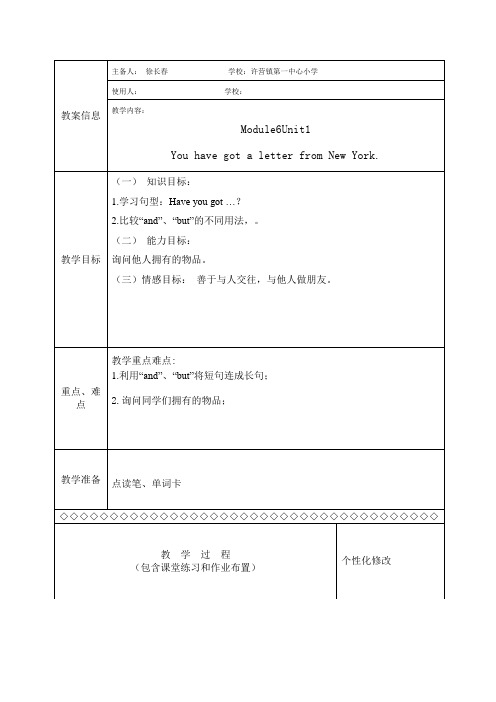
重点、难点
教学重点难点:
1.利用“and”品;
教学准备
点读笔、单词卡
◇◇◇◇◇◇◇◇◇◇◇◇◇◇◇◇◇◇◇◇◇◇◇◇◇◇◇◇◇◇◇◇◇◇◇◇◇◇
教学过程
(包含课堂练习和作业布置)
个性化修改
教学过程:
一.Warmer
E.g.: T: (pick up a book) Have got a book.
Repeat this activity with the rest of the objects.
Practice “ I have got…. and I’ve got…”
二.Listen, point and find ‘have got’.
Write on the board
Daming has got…Laura has got….
sk the students to close their student’s books.
Before they listen, ask them to guess what objects Laura and Daming have got.
Then, play the recording and ask the students to listen and check if their guesses are correct.
三.Listen and say.
After practicing the phrases, encourage the students to ask each other question.
教案信息
主备人:徐长春学校:许营镇第一中心小学
使用人:学校:
外研版小学英语(一年级起点)六年级上册Module6 Unit1 参考教案
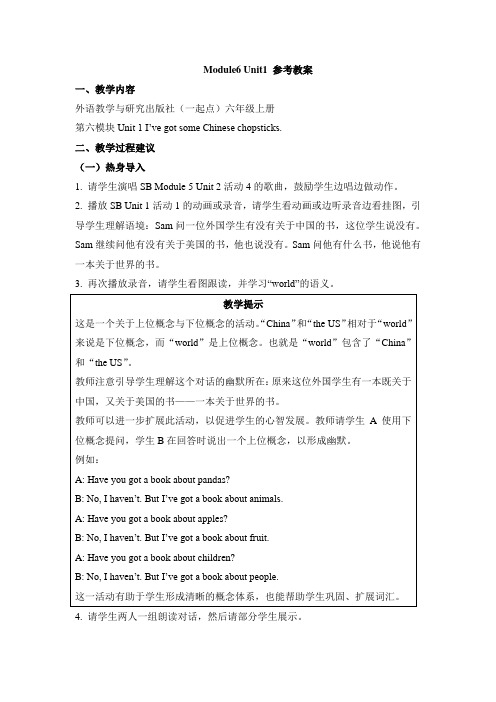
Module6 Unit1 参考教案一、教学内容外语教学与研究出版社(一起点)六年级上册第六模块Unit 1 I’ve got some Chinese chopsticks.二、教学过程建议(一)热身导入1. 请学生演唱SB Module 5 Unit 2活动4的歌曲,鼓励学生边唱边做动作。
2. 播放SB Unit 1活动1的动画或录音,请学生看动画或边听录音边看挂图,引导学生理解语境:Sam问一位外国学生有没有关于中国的书,这位学生说没有。
Sam继续问他有没有关于美国的书,他也说没有。
Sam问他有什么书,他说他有一本关于世界的书。
3. 再次播放录音,请学生看图跟读,并学习“world”的语义。
4. 请学生两人一组朗读对话,然后请部分学生展示。
(二)任务呈现教师对学生说:“同学们,为了拓宽大家的阅读面,我们班要扩大图书角的规模(如果班级原来没有图书角,则说要建立班级的图书角)。
因此,请各位同学提供图书,与其他同学一起分享。
这节课先请大家介绍自己拥有什么种类的书,下节课再请大家提供可以用于交换阅读的书,好不好?在这之前,我们还是先来学习课文,看一看如何用英语表达‘拥有’某物。
”(三)课文学习1. 播放SB Unit 1活动2的动画或录音,请学生看动画或边听录音边看挂图。
教师帮助学生理解课文语境。
2. 再次播放录音,请学生完整听一遍课文,进一步理解语句。
播放第三遍录音,请学生逐句跟读。
对于学生跟读有困难的语句,教师先带读较难词语,然后按照意群、节奏重点带读,请学生注意模仿语音语调。
3. 在跟读过程中,通过展示图片、做动作、说明等方式,学习“difficult, answer”的语义,并进行运用训练。
4. 请学生观察、分析、归纳对话中“have/has got...”的特点及基本用法,并训练“have/has got...”与不同人称的搭配使用。
5. 教师请学生说一说对话中连接语句的连词“but”和“and”的语义,并请学生观察、分析、归纳“but”和“and”的特点及基本用法。
外研版(一起)六年级英语上册教案Module6Unit1(5)

外研版一起六年级英语上册Module6 Unit1 I’ve got some Chinese chopsticks.教材:一年级起点《新标准英语》第十一册第六模块第一单元课题:Module6 Unit1< I’ve got some Chinese chopsticks>.主题:给笔友写信介绍自己的情况并询问对方的相关情况。
教学目标:知识目标:掌握并熟练运用have got的各种形式和句式。
能力目标:1.能够熟练运用have got 的各种句式表达自己或他人拥有某物以及询问他人是否拥有某物。
2.以一封信为载体,综合运用以上语言结构与笔友进行交流。
情感态度目标:1.关注学生良好学习习惯的养成。
2.向学生渗透国际间文化的差异。
重点:1.引导学生梳理并归纳“have got”的各种形式既句式,并达到熟练运用。
2.掌握书信的格式,了解书信的相关内容。
难点:表达准确,符合书写规范及语法规范。
教具准备:PPT演示课件,小礼物等。
教学过程:1. OrganizationGreetings between teacher and students.2. RevisionT: Children, do you remember my hobby?S: Your hobby is collecting postcards.T: Yes. Several days ago, I sent my favorite postcard to my pen pal in England. (ppt) There is a very famous place in China on it. Please guess where it is?S: Is it the Great Wall\ the Summer palace\ the Ming Tombs….T: ( ppt) Look , It’s the Great Wall. Can you tell us about the Great Wall?S: It’s long. It’s ten thousand li long. And it’s very old. It’s more than two thousand years old.T: Good. And yesterday , I received a postcard from my pen pal. Also there is a place on it, please guess.(Let students say something about Chinatown as the Great Wall.)【教师将本学期第一、二模块的内容有机的整合到这节课当中,使前面学过的知识在后面的学习过程中有反复呈现的机会和过程,有利于学生复习和记忆】T: My pen pal sent me a letter, too. But something happe ned with my letter, I can’t see it clearly. Please help me complete the letter.【通过一封来自英国的信,学生即复习了各类型的知识点,如:介词,单复数,时态等,又交代了本课的任务——给笔友写一封信,而且巧妙地引出了下一个送礼物的活动,一举三得。
外研版(三起点)六年级英语上册《Module6_Unit1_大连优课教案》
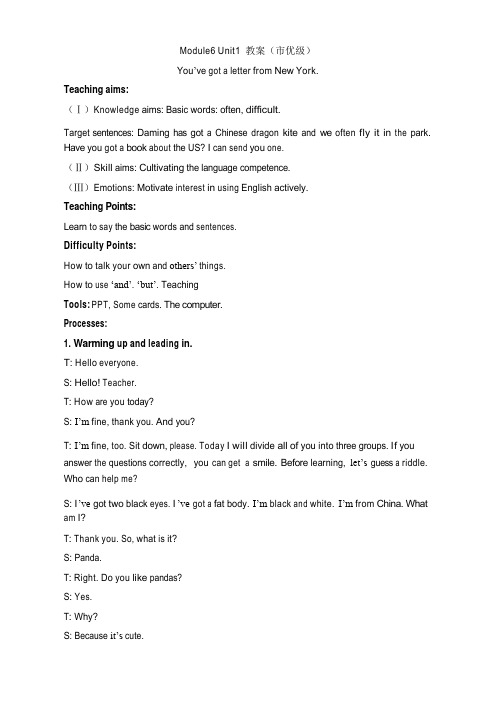
Module6Unit1教案(市优级)You’ve got a letter from New York.Teaching aims:(Ⅰ)Knowledge aims:Basic words:often,difficult.Target sentences:Daming has got a Chinese dragon kite and we often fly it in the park. Have you got a book about the US?I can send you one.(Ⅱ)Skill aims:Cultivating the language competence.(Ⅲ)Emotions:Motivate interest in using English actively.Teaching Points:Learn to say the basic words and sentences.Difficulty Points:How to talk your own and others’things.How to use ‘and’. ‘but’.TeachingTools:PPT,Some cards.The computer.Processes:1.Warming up and leading in.T:Hello everyone.S:Hello!Teacher.T:How are you today?S:I’m fine,thank you.And you?T: I’m fine,too.Sit down,please. Today I will divide all of you into three groups.If you answer the questions correctly,you can get a smile.Before learning,let’s guess a riddle. Who can help me?S:I’ve got two black eyes.I’ve got a fat body.I’m black and white.I’m from China.What am I?T:Thank you.So,what is it?S:Panda.T:Right.Do you like pandas?S:Yes.T:Why?S: Because it’s cute.T:Yes,it’s cute. I love pandas, too.Because they are from China.I love China.I ’ve got a book about China.Have you got a book about China?S:Yes,I have.T:He has got a book,too.Has he got a book about China? Now,watch the cartoon and find the answer.Has he got a book about China?S:No,he hasn’t.T:Who can ask?S:Has he got a book about the US?T:The answer is...S:No,he hasn’t.T:Yes, he hasn’t got a book about China.He hasn’t got a book about the US. He has got a book about the world.Look at the picture.or→/3:/world.You,please. Repeat.(Teach world)S:or→/3:/world.T: I’ve got a picture of the world.Now open your books.Then turn to page thirty-two. Watch the cartoon and repeat.S:...T:Great.Look!You’ve got a letter!Where is it from?S:New York.T:Yes.Today we will learn Module6Unit1You’ve got a letter from New York.(Write the title on the blackboard.Module6 Unit1You’ve got a letter from New York.) Group one repeat.S:You’ve got a letter from New York.T:Group two repeat.S: You’ve got a letter from New York.2.Task Presentation.T:Who can read it?S: Learn some new words:word.often.difficult.Review how to use have/has got to make sentences.And review how to connect two sentences with and/but.After learning,let’s write a letter to your pen friend.3.Text Learning.T:You’ve got a letter from New York,but it’s not from Daming.Who wrote it?Now,watch the cartoon and find the answer.Who wrote it?S:Laura.T:ura wrote this letter. What did she write?Now listen the first paragraph.There are two questions.Who can help me?S:Laura is Daming’s ura lives in New York,so she is American.T:The first one true or false.S:True(T)T:Great!Who can answer the second one?S: False.She is British.T:Great.But I am not American.So we are all British.Let’s continue.Listen the secondparagraph and choose the correct answer.Daming has got a Chinese dragon kite.Letter or ura often makes a kite.Rides bikes or flies the dragon kite with Daming.Look at this word:often.o-f-t-e-n.Spell it one by one.(Write the word on the blackboard:often)S: o-f-t-e-n.often.T:It is easy.difficult or different for her.Look at this word.You please.(Write the word on the blackboard:difficult)Now,listen and choose.You can discuss with your partner.Who can answer the first one? S: Daming has got a Chinese dragon kite.Choose A.T:Right.Let’s say together.(Write the sentence on the blackboard.Daming has got a Chinese dragon kite)Who can answer the second one?S:Laura often flies the dragon kite with Daming.T:Yes,it is easy.difficult or different for her.S:It is difficult for her.T:Yes,we choose ura flies a kite with Daming. Where do they often fly a kite?S:They often fly it in the park.T:Right.Let’s see.We often fly it in the park.Repeat, please.(Write the sentence on the blackboard.We often fly it in the park.)S:We often fly it in the park.T:Listen the third paragraph and find the Laura’s question.Have you found it?S:Have you got a book about the US?T:Right.Say it again.(Write the sentence on the blackboard.Have you got a book about the US?)Has Laura got a book about the US?S:Yes,she has.T:Where did you find?S:I can send you one.T:Yes,you are so clever. Say together.(Write the sentence on the blackboard.I can send you one.)Watch the cartoon and repeat.Pay attention to your pronunciation.S:...T:Look!Some words are missing!Now,work in pairs and find them back.Are you clear? S: Yes.T:Come on!Begin!Who want to try?S:...T:Now,I am Laura.I wrote this letter.Amy and Sam have got a letter from New York.I live in New York,but I am not American.I am from London in the UK. Do you like China? I want to visit China next year.Daming has got a dragon kite and we often fly it in the park. Have you got a book about about the US?I can send you one. Now,you can Laura.You read this letter.Have a practise.S:...T:Daming has got a Chinese dragon kite.We often fly it in the park.And or but?S:And.T:Right.(Write the word on the blackboard:and)4.Practise.Let’s do more practice about ‘but’‘and’.Look at this picture.What’s this?S:A TV.T:Right.I have got a TV.Who can make the sentence?S:I haven’t got a football.T:I have got a TV. I haven’t got a football.‘and’or‘but’?S:butT:You are so clever. Read together.S:I have got a TV,but I haven’t got a football.T:Let’s continue.This is a pet dog.This is a pet cat.Who can make the sentence?S:I have got a pet dog.T:Partner.S:I have got a pet cat.T: Say together.I have got a pet dog and I have a pet cat.Now,use‘and’or‘but’to complete the sentences.Who wants to try?S: I’ve got a kite,but I can’t fly it.T:Good! Next one.S:Sam has got a dog and he often play with it.T:Next one.S:I live in New York,but I am not American.T:Continue.She’s got an email in French, but she S:I’ve got a postcard and it’s from my pen friend.can’t read it.T:The last one.Say together.S:I want to go swimming,but I’ve got a cold.T:You are so clever.5.Task Completion.T:What have you got?S:I have got a pen.T:What have you got?S:I have got a bicycle.T:You can ask your partner.S: What have you got?I have got a TV.I have got some stamps.I have got a football.T:What have you got?Say together.S:I have got a pen friend.T: This is your friend,Tina.Let’s write to her. Who can read the first paragraph?S:Dear Tina, I want you to be my friend.I live in . Do you like China?Welcome toChina someday.T:Have you finished it?Who wants to try?S:...T:Do you like your friends?S:Yes.T:We often play together.And we cook meals.We are very happy,right?So,let’s help each other.A friend is a present which you give yourself.What have you learnt today?S:We learned some new words:‘often and difficult’.T:Anyone else?S:And we learn two sentences.Daming has got a Chinese dragon kite and we often fly it in the park.Have you got a book about the US?I can send you one.T:Great.Today’s homework.First,copy the words:often.difficult for five times.Read the letter three times.And I will check tomorrow.。
外研版英语六年级上册第六模块第一单元教案
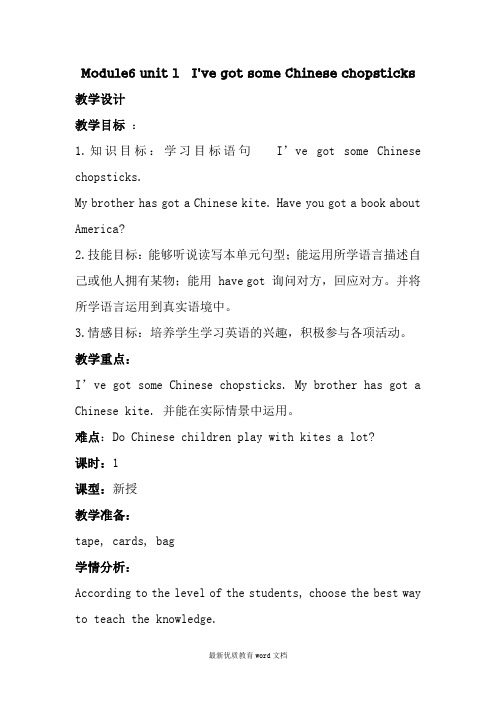
Module6 unit 1 I've got some Chinese chopsticks 教学设计教学目标:1.知识目标:学习目标语句I’ve got some Chinese chopsticks.My brother has got a Chinese kite. Have you got a book about America?2.技能目标:能够听说读写本单元句型;能运用所学语言描述自己或他人拥有某物;能用 have got 询问对方,回应对方。
并将所学语言运用到真实语境中。
3.情感目标:培养学生学习英语的兴趣,积极参与各项活动。
教学重点:I’ve got some Chinese chopsticks. My brother has got a Chinese kite. 并能在实际情景中运用。
难点:Do Chinese children play with kites a lot?课时:1课型:新授教学准备:tape, cards, bag学情分析:According to the level of the students, choose the best way to teach the knowledge.教教学设计Step1: Warmer师生问候。
做游戏 Simon says. 教师在发出指令前说Simon says ,则学生做此动作;指令前没有 Simon says ,则不做此动作。
这个游戏主要复习第四和第五模块的内容。
如:Simon says: I can run. ( 此时学生做跑的动作 )。
They can jump. ( 此时学生不能做跳的动作,做动作的学生被淘汰 )。
运用这个游戏活动,能够集中学生的注意力,激发学生的学习兴趣,创造英语学习的氛围,同时又使已学知识得以应用和巩固,为新授开了个好头。
Step 2: Presentation (介绍新语言项目)a.教师出示课文课件,请学生看图,带着问题听一遍录音:这封信是谁写给Lingling 的?(课件播放课文录音,带着问题听录音)你听了几个have got 和 has got ?听完后请学生说出答案,使学生对课文有个初步的了解。
小学英语外研新标准六年级上册Module6Module6Unit1教学设计

1. T shows thepicsand asks the Ss tospeak.
Please ask with “What have you got…?”
2.Have you got...?
通过小组活动和视频,激发学生的学习兴趣。同时对任务完成过程中将涉及到的句式予以初步渗透。
Practice 2
To foster students’ abilities of writing.
What have you got in your room?
Step 6 Emotion
Even if you haven’t got anything, you also have got ambition.
Yes,he/she has./ No, he/she hasn’t.
Step 5Summary
Sum up
I/you/we/they have got
He/she/it has got
Practice 1
To enable students finish practice aபைடு நூலகம்out“have got and has got”
Step3while-task
Listen and judge
T: Let’s listen to the text and judge.
1. Thisvideois fromYang Chaunying..
2.What book have you got?.
Book
English、Chinese、Math、animal
通过听音判断,听音回答问题等形式帮助学生进一步理解句式,并且通过适当的口头练习帮助学生提高英语口语的表达能力。
六年级英语上册教案Module 6 Unit 1 外研版一起

Module 6.本模块是外研社出版的《新标准英语》第十一册第六模块第一单元的教学内容,本课主要是能用英语调查并描述自己和其他同学所拥有的东西。
通过学习本课课文激发学习的兴趣,同时学会如何与笔友写信、交流,陶冶情操。
通过本课的学习激发学生用英语表达自己爱好的欲望,提高英语口语生活化。
【知识目标】1、能听说读写新词chopsticks difficult answer city.2、能够听说读写句型I’ve got some Chinese chopsticks. My brother has got a Chinese kite. Have you got a book about America?【能力目标】1、能够听说读写本单元句型;2、能运用所学语言描述自己或他人拥有某物;3、能用 have got 询问对方,回应对方。
并将所学语言运用到真实语境中。
【情感目标】培养学生学习英语的兴趣,积极参与各项活动。
掌握句型I’ve got a/some…。
She/He has got a/some…。
Have you got a/some…?并能在实际情景中运用。
【教学难点】1. 能灵活运用have got的句型。
2. 能运用到实际生活中写简单的教师准备多媒体课件,单词卡片等。
教学过程Step1. Warming up1.Greeting2.Chant:(课件呈现)Have got, have got, I have got a pen pal. Have you got a pen pal? Yes, I have. Yes, I have. Has got, has got, he has got a pen pal. Has he got a pen pal? Yes, he has. Yes, he has.Step2. Preview1. T shows the bag and asks the Ss to guess.T: Guess! What have I got in my bag?Please ask with “Have you got…”2. Ss take out the pieces of paper written 2 riddles. Then read and others guess.(1) It can fly in the sky. It’s like(像) a big bird. Chinese children play with(和…玩) it a lot(经常).(2)They are difficult for(对…有困难的) English people. We can use it to eat noodles.3. Teach “chopsticks”4.Chopsticks are easy for us, but they are very difficult for foreign people.Teach “difficult”操练Chopsticks are very difficult for Amy /Sam / Laura.5.Teach “answer”Why chopsticks are very difficult for foreign people? Who can answer my question? Teach “answer”.Step3. PresentationT:Do you remember Laura? Where does she from? Who did she meet in New York? What does she want?Ss: She is from America. She met Daming in New York. She wants a Chinese pen pal.T:Yes, she wants a Chi nese pen pal. So she wrote a letter to Lingling. Let’s go to see this letter. Open you book, today we are learn Module6 Unit1 I’ve got some Chinese chopsticks.1.Listen repeat and find “have got”.2.Read sentences “I’ve got long, red hair and blue eyes. I’ve got some Chinese chopsticks.”3.Listen repeat again and with questions.(先整体听一边,再分段听,并回答问题)(1) Who is the letter from?It is from Laura.(2) What food does she like?She likes Chinese food.(3) What has she got?She has got some Chinese chopsticks.(4) What has her brother got?He has got a Chinese kite.4.Read the text together.Step4. Practice让学生用have got 和has got 造句。
(外研版)六年级英语上册教案Module6Unit1(2)
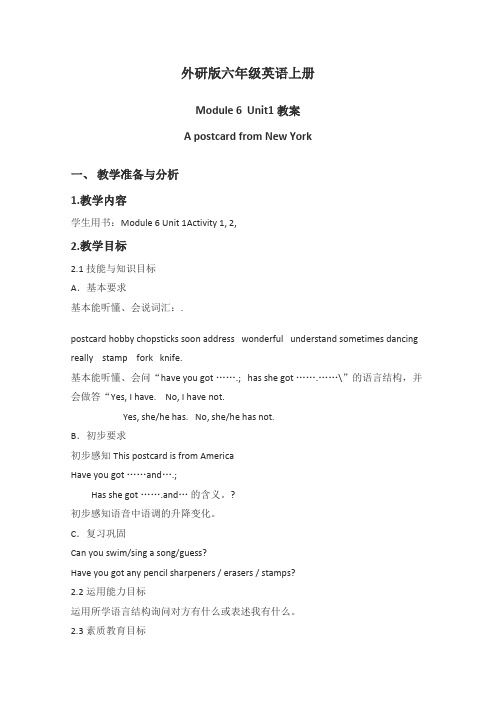
外研版六年级英语上册Module 6 Unit1教案A postcard from New York一、教学准备与分析1.教学内容学生用书:Module 6 Unit 1Activity 1, 2,2.教学目标2.1技能与知识目标A.基本要求基本能听懂、会说词汇:.postcard hobby chopsticks soon address wonderful understand sometimes dancing really stamp fork knife.基本能听懂、会问“have you got …….; has she got …….……\”的语言结构,并会做答“Yes, I have. No, I have not.Yes, she/he has. No, she/he has not.B.初步要求初步感知This postcard is from AmericaHave you got ……and….;Has she got …….and…的含义。
?初步感知语音中语调的升降变化。
C.复习巩固Can you swim/sing a song/guess?Have you got any pencil sharpeners / erasers / stamps?2.2运用能力目标运用所学语言结构询问对方有什么或表述我有什么。
2.3素质教育目标帮助学生明确学习目标,培养学生自主、合作的学习方式。
培养学生英语学习的乐趣,使他们在小组中积极与他人合作,共同完成任务;创设运用语言的真实语境。
培养学生熟悉生活,对生活中常用句子的理解和运用。
3.教学重点词汇someday soon knife fork chopsticks dance sing swim visit in the park live in 句式 a postcard from New YorkHave you got ……? Yes, I have No, .I have notHas she got…….?. Yes, she/he has. No, she/he has not. .4.教学难点句式 I have got some stamps from China.I have got some …….and………but, I have not ………5.任务设计A.学习任务学习巩固词汇postcard hobby. Live in. visit. Chopsticks. Soon句型 Have you got ……? Has she got…….? I have got …….?B.运用任务1:SB Unit1 活动 32:AB Unit 1练习 23.给自己的笔友或朋友写一个明信片。
- 1、下载文档前请自行甄别文档内容的完整性,平台不提供额外的编辑、内容补充、找答案等附加服务。
- 2、"仅部分预览"的文档,不可在线预览部分如存在完整性等问题,可反馈申请退款(可完整预览的文档不适用该条件!)。
- 3、如文档侵犯您的权益,请联系客服反馈,我们会尽快为您处理(人工客服工作时间:9:00-18:30)。
Module6 unit 1 I've got some Chinese chopsticks 教学设计
教学目标:
1.知识目标:学习目标语句I’ve got some Chinese chopsticks.
My brother has got a Chinese kite. Have you got a book about America?
2.技能目标:能够听说读写本单元句型;能运用所学语言描述自己或他人拥有某物;能用 have got 询问对方,回应对方。
并将所学语言运用到真实语境中。
3.情感目标:培养学生学习英语的兴趣,积极参与各项活动。
教学重点:
I’ve got some Chinese chopsticks. My brother has got a Chinese kite. 并能在实际情景中运用。
难点:Do Chinese children play with kites a lot?
课时:1
课型:新授
教学准备:
tape, cards, bag
学情分析:
According to the level of the students, choose the best way to teach the knowledge.
教教学设计
Step1: Warmer
师生问候。
做游戏 Simon says. 教师在发出指令前说Simon says ,则学生做此动作;
指令前没有 Simon says ,则不做此动作。
这个游戏主要复习第四和第五模块的内容。
如:Simon says: I can run. ( 此时学生做跑的动作 )。
They can jump. ( 此时学生不能做跳的动作,做动作的学生被淘汰 )。
运用这个游戏活动,能够集中学生的注意力,激发学生的学习兴趣,创造英语学习的氛围,同时又使已学知识得以应用和巩固,为新授开了个好头。
Step 2: Presentation (介绍新语言项目)
a.教师出示课文课件,请学生看图,带着问题听一遍录音:这封信是谁写给Lingling 的?(课件播放课文录音,带着问题听录音)
你听了几个have got 和 has got ?听完后请学生说出答案,使学生对课文有个初步的了解。
b.让学生打开书,教师再放一遍录音,请学生边听边指出have got 和 has got 在课文中
的位置。
c.再听录音,对课文进行进一步的理解。
请学生根据课文回答老师的问题:What has Laura got? What has her brother got? 她用 have got 向Lingling提了一个什么问题?以此引出三个
重点句。
Step 3. Practice (练习)
a. 练习本课重点句。
抽查部分学生,特别是学困生。
b. 理解句意:Do Chinese children play with kites a lot? 让学生用 play with 造句或组成词组。
如:play with toys; play with dolls___加深对这个句子的理解。
c. 自读课文,提问题。
再请其他学生解答。
d. 两人小组读课文。
创设情景,鼓励学生在表演的过程中加上动作和表情。
这一环节是一个机械操练的阶段,目的让学生更好、更准确的学习语言,掌握语言。
通过学生对课文的感知―理解,小梯度,多台阶地强化了学生对语言知识的理解与掌握。
e. Game:She's got long black hair.
She's got a dog.
She's got red coat.
Who is she ?
猜猜是谁?这个游戏操练重点句型,让孩子更好的掌握重点。
Step 4 :Production (任务完成)
a. 完成课堂活动用书练习1,使学生进一步加深对课文的理解与掌握。
完成后两人一组进行问答,检查答案。
b. 完成学生用书活动2:学生听录音,然后练习背诵,使
学生对本课的重点句子掌握到位。
c. 完成课堂活动用书练习2,巩固练习本课的重点句型,使学生掌握不同人称的陈述句和疑问句。
听音连线后,请学生完整地说出这些句子。
d. 完成学生用书活动3。
可分组合作学习:同学们来到了野营地,他们要在这里踏青,野炊,每位同学带来了一些必要的用品。
请同学们互相了解一下大家所带物品的情况,如:I have got some apples. Have you got any apples? 等。
大家带的物品可能会不同,教育引导学生要互相关心,互相帮助,在团结友爱的气氛中愉快地游玩。
小组中每用上一个 have got 句型,就加一分。
e. 让学生用 have got 和 has got 造句。
把学生分成小组,每次每组派一名学生参赛,说得又快又正确的学生得分。
有新意的可获得加分。
如:回答问题的学生用的都是陈述句,第一个用疑问句的学生可获得加分。
得分高的小组获胜。
通过完成任务,增强了学生间的了解,促进了学生之间的交流。
同时,学生学会了并运用了本课的语言知识。
f."滚雪球”采用这个游戏,让孩子把本课的举行都串联起来,起到复习巩固和总结本节课重点内容的作用。
g.Write a letter to Laura. 锻炼孩子书写的能力,综合运用所学知识。
Step5. Home work (小结与作业)
Finish the letter .并且和小组成员讨论,写信的内容。
板书设计:(略)
教学反思:复习环节:我设计了一个“Magic Box”的小游戏来辅助复习Have you got…? Yes, I have./ No, I haven’t.孩子们积极性很高,因为这一游戏充分利用了孩子好奇心强的特点,吸引他们去猜盒子里面是什么,猜中了就归她/他,孩子们争先恐后地参与进来,达到了广泛的复习效果。
